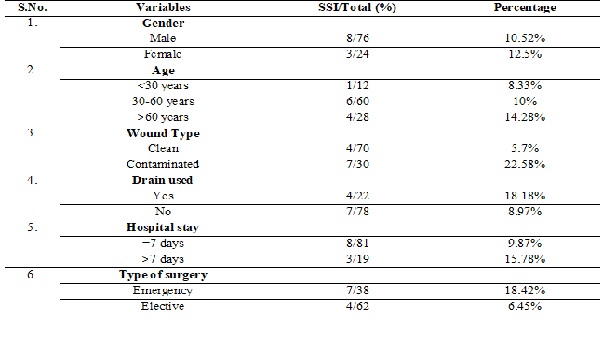Evaluation of risk factors for surgical site infection following abdominal surgeries
Abstract
Objective:surgical site infections (SSIs) are substantial cause of morbidity and mortality among the hospitalized patients. The present study was performed to analyze the incidence of SSIs and to evaluate the risk factors for SSI following abdominal surgeries at a tertiary healthcare centre.
Material & Methods: The present study is a prospective study carried out in the Department of general surgery, Dungarpur Medical College & Hospital, Rajasthan during the period of 1 year from January 2018 to January 2019. A total of 100 elective and emergency cases of abdominal surgeries were included in the study.
Results: 76 patients were male and 24 were female. Age of the patients ranges from 15 to 70 years with the mean age of 52.2 years. Out of 100 procedures, 38 were emergencies and 62 were elective procedures. 11 cases of SSIs were encountered during the study period. Exploratory laparotomy was the surgery most commonly associated with SSIs (4 cases), followed by bowel resection (3 cases) and cholecystectomy (2 cases).
Conclusion: Post -operative surgical site infections causes substantial increase in morbidity and mortality associated with the disease and also increase the healthcare cost. Meticulous surgical techniques, minimizing the duration of operation, proper sterilization, hygienic operation theatres and ward environments are few of the habits which can reduce the risk of SSIs.
Downloads
References
2. Barie PS, Wilson SE. Impact of evolving epidemiology on treatments for complicated skin and skin structure infections: the surgical perspective. J Am Coll Surg. 2015 Jan;220(1):105-116.e6. doi: 10.1016/j.jamcollsurg. 2014.02.039. Epub 2014 Nov 21.[pubmed]
3. Horan TC, Andrus M, Dudeck MA. CDC/NHSN surveillance definition of health care-associated infection and criteria for specific types of infections in the acute care setting. Am J Infect Control. 2008 Jun;36(5):309-32. doi: 10.1016/j.ajic.2008.03.002.[pubmed]
4. Berard F, Gandon J. Postoperative wound infections: the influence of ultraviolet irradiation of the operating room and of various other factors. Ann Surg. 1964 Aug;160(Suppl 2):1-192.[pubmed]
5. Kampf G. The six golden rules to improve compliance in hand hygiene. J Hosp Infect. 2004 Apr;56 Suppl 2:S3-5. DOI:10.1016/j.jhin.2003.12.023.[pubmed]
6. Tumia N, Ashcroft GP. Convection warmers--a possible source of contamination in laminar airflow operating theatres? J Hosp Infect. 2002 Nov;52(3):171-4.[pubmed]
7. Brandt C, Hott U, Sohr D, et al. Operating room ventilation with laminar airflow shows no protective effect on the surgical site infection rate in orthopedic and abdominal surgery. Ann Surg. 2008 Nov;248(5):695-700. doi: 10.1097/SLA.0b013e31818b757d.[pubmed]
8. Mangram AJ, Horan TC, Pearson ML, et al. Guideline for Prevention of Surgical Site Infection, 1999. Centers for Disease Control and Prevention (CDC) Hospital Infection Control Practices Advisory Committee. Am J Infect Control. 1999 Apr;27(2):97-132; quiz 133-4; discussion 96.[pubmed]
9. Horan TC, Andrus M, Dudeck MA. CDC/NHSN surveillance definition of health care-associated infection and criteria for specific types of infections in the acute care setting. Am J Infect Control. 2008 Jun;36(5):309-32. doi: 10.1016/j.ajic.2008.03.002.[pubmed]
10. Raka L, Krasniqi A, Hoxha F, et al. Surgical site infections in an abdominal surgical ward at Kosovo Teaching Hospital. J Infect Dev Ctries. 2007 Dec 1;1(3):337-41.
11. Anshul kumar, Arpita Rai. Prevalance of surgical site infection in general surgery in a tertiary care centre in India. Int Surg J. 2017 Sept; 4(9): 3101-3106.
12. Keping Cheng, Jiawei Li, Qingfangkong, Changxian Wang, Nanyuan Ye, Guohua Xia. Risk Factors for surgical site infection in a teaching hospital: A prospective study of 1,138 patients. Patient Preference and Adherence 2015 Aug; 9: 1171-1177.doi: 10.2147/PPA.S86153
13. Brandt C, Sohr D, Behnke M, et al. Reduction of surgical site infection rates associated with active surveillance. Infect Control Hosp Epidemiol. 2006 Dec;27(12):1347-51. Epub 2006 Nov 21. DOI:10.1086/ 509843.[pubmed]
14. Prospero E, Cavicchi A, Bacelli S, et al. Surveillance for surgical site infection after hospital discharge: a surgical procedure-specific perspective. Infect Control Hosp Epidemiol. 2006 Dec;27(12):1313-7. Epub 2006 Nov 21.[pubmed]
15. Fiorio M, Marvaso A, Viganò F, et al. Incidence of surgical site infections in general surgery in Italy. Infection. 2006 Dec;34(6):310-4. DOI:10.1007/s15010-006-6632-0.[pubmed]
16. Semiannual report aggregated data from the National Nosocomial Infections Surveillance (NNIS) System June 2000. Available at [http://www.cdc.gov/ncidod/dhqp/pdf/nnis/une2000sar.pdf].
17. Tripathy BS, Roy N. Post-operative wound sepsis. Ind J Med.1984;46 (6):285-8.
18. Chapter IV Factors Influencing the Incidence of Wound Infection. Ann Surg. 1964 Aug;160(Suppl 2):32-81.[pubmed]
19. Cruse PJE. Surgical wound infection. In: Gorbach SL, Bartlett JG, Blacklow NR editors. Infectious diseases. WB Saunders Company, Harcourt Brace Jovanovich, Inc.: Philadephia, London, Toronto, Montreal, Sydney, Tokyo; 1992: Vol. 16; issue 1: 738-64. http://doi.org/10.1002/hep.1840160142
20. Beck WC, Deshmukh N. Surgical infections. In: Groschel D, editor. Handbook on hospital associated infections in the general hospital population and specific measures of control. Marcel Dekker, Inc: New York, Basel; 1979; Vol. 3 (1): 1-24.
21. Cruse PJ, Foord R. A five-year prospective study of 23,649 surgical wounds. Arch Surg. 1973 Aug;107(2):206-10.[pubmed]



 OAI - Open Archives Initiative
OAI - Open Archives Initiative


















 Therapoid
Therapoid

